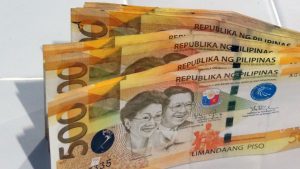Concern grows as NG debt hits new record

THE NATIONAL Government (NG) debt hit another record as of end-July, but economists expressed concern whether the government can generate enough revenues for the eventual repayment of the large borrowings incurred during the pandemic.
The NG outstanding debt rose by 0.8% or P96.09 billion to a record-high P12.89 trillion at the end of July, beating the previous high of P12.79 trillion as of end-June, due to additional domestic and local borrowings, as well as a weaker peso.
The Bureau of the Treasury (BTr) said the debt pile jumped by 9.9% since the year started, after the government borrowed P1.16 trillion more. Year on year, the debt stock jumped by 11% from P11.61 trillion.
“Outstanding National Government debt may have continued to increase on a month-on-month basis but the figure is still nearly half the average monthly increase of about P165 billion from 2020 to June 2022, or P2 trillion per year from 2020 to 2021 when there were hard lockdowns,” Rizal Commercial Banking Corp. Chief Economist Michael L. Ricafort said in a Viber message.
“This reflects the narrowing of the budget deficit in terms of the faster growth in government tax revenue collections and the slower growth in government expenditures amid recent measures to further reopen the economy towards greater normalcy,” he added.
In the first seven months of 2022, the budget deficit narrowed by 9.11% to P761 billion.
To address the over P5 trillion in debt incurred since the pandemic began, Mr. Ricafort said that the Marcos administration still needs to intensify revenue collections, implement fiscal reforms and anti-corruption efforts.
“[These] would help narrow the budget deficit and, in turn, slow the growth or increment in the National Government’s outstanding debt, as well as better prepare for the eventual payment of the large borrowings incurred during the pandemic,” Mr. Ricafort said.
Ateneo de Manila University economics professor Leonardo A. Lanzona said the slower rise in debt can mean the government is “becoming more prudent with our resources or it can mean that we are now losing ground in terms of our ability to borrow.”
“It is alright to borrow if the growth rate is higher than the cost of borrowing,” he said.
Economist John Paolo R. Rivera from the Asian Institute of Management (AIM) said the government is not significantly adding debt compared to the height of the pandemic.
“The concern should be more of whether we are generating enough income to do debt payments while [we] continue providing social services,” he said.
As of end-July, outstanding local borrowings reached P8.83 trillion, 0.7% up from the end-June level. The BTr attributed the increase to the net issuance of government securities amounting to P64.33 billion and the P750-million impact of the peso’s depreciation against the US dollar.
Domestic debt was 8.8% higher than the P8.12 trillion a year earlier, and 8.1% higher than the end-December 2021 level of P8.17 trillion.
Most of the domestic debt stock still came from government securities with P8.83 trillion in July, up by 16.5% year on year, and 0.7% month on month.
Meanwhile, outstanding external debt jumped by 16.2% year on year to P4.06 trillion as of end-July. It inched up by 0.8% month on month, and increased by 14% from the end-December 2021 level.
Broken down, it consisted of P1.82 trillion in foreign loans and P2.24 trillion in global bonds.
“The increment in the level of external debt was attributed to the impact of local currency depreciation against the (US dollar) amounting to P25.77 billion and net availment of external financing amounting to P6 billion,” the Treasury said.
AIM’s Mr. Rivera said that the incremental increase of the debt was expected seeing how the Philippine peso breached the P56-to-a-dollar level.
The peso closed at a new record low against the dollar on Friday at P56.77, accounting for an 11.31% depreciation against the greenback in the year to date ending Sept. 2.
The government expects the peso to settle between P51 and P55 in 2023.
“If inflation is not arrested, it would also be challenging to manage forex to P51 to P55 but this can be achieved with the right monetary policy and meeting target economic growth,” Mr. Rivera said.
Meanwhile, overall guaranteed debt decreased month on month by 1.4% to P408 billion as of end-July. It was also 8.2% lower than the P444.31 billion as of July 2021.
This was attributed to P8.56 billion in net repayment of domestic guarantees and the net repayment of external guarantees amounting to P190 million.
“However, currency adjustments on both local and third currency-denominated guarantees were able to offset P1.4 billion and P1.43 billion, respectively,” the BTr said.
Outstanding debt is expected to rise to P13.43 trillion by the end of 2022.
Mr. Lanzona said the limited fiscal resources should instead be focused on social assistance and strategically located infrastructure projects.
“Not all infrastructure is inefficient. But if the infrastructure is going to be placed in the urban areas and is not going to improve productivity, this will be inefficient and will not benefit everyone, especially the poor. While it is true that returns from infrastructure exist, there are other investments such as education and health that have greater social returns,” he said in an e-mail.
Of the outstanding debt in July, the bulk or 68.53% was obtained domestically, while the rest was from foreign creditors.
Finance Secretary Benjamin E. Diokno said that the government is pursuing a borrowing mix of 75-25 this year in favor of domestic lenders. Eventually, the government will try to increase it to 80-20 to minimize foreign exchange risks.
“Tax reform and other fiscal reform measures, alongside faster economic growth, for the coming months would help ease the National Government’s debt-to-GDP ratio to below the international threshold of 60% and would help support the country’s relatively favorable credit ratings of 1-3 notched above the minimum investment grade rating,” Mr. Ricafort said.
The country’s debt level reached 62.1% of GDP at the end of the second quarter, from 54.6% as of end-2020 and 39.6% as of-end 2019. It is expected to steadily drop to 61.8% by end-2022, and to 52.5% by 2028.
Fitch Ratings in February maintained the Philippines’ investment-grade “BBB” rating, but retained a “negative” outlook, flagging uncertainties surrounding medium-term growth and hurdles to bringing down debt. A negative outlook means a downgrade is possible within the next 12 to 18 months.
S&P Global Ratings last affirmed the Philippines’ “BBB+” rating with a “stable” outlook in May 2021. Meanwhile, Moody’s last affirmed its “Baa2” credit rating with a stable outlook for the Philippines in July 2020.
The government borrows from local and external sources to help fund a budget deficit capped at P1.65 trillion this year, equivalent to 7.6% of gross domestic product. — Diego Gabriel C. Robles




